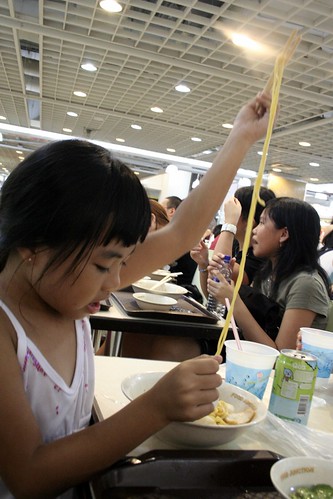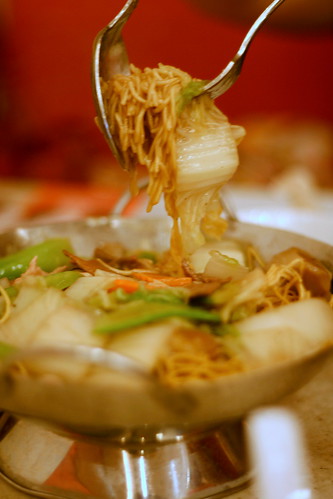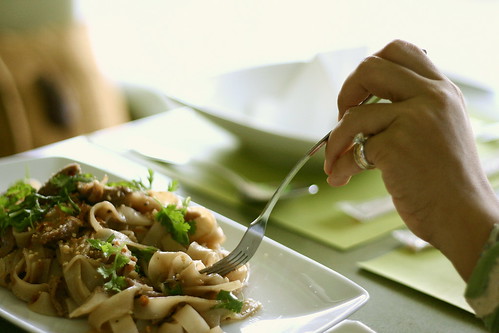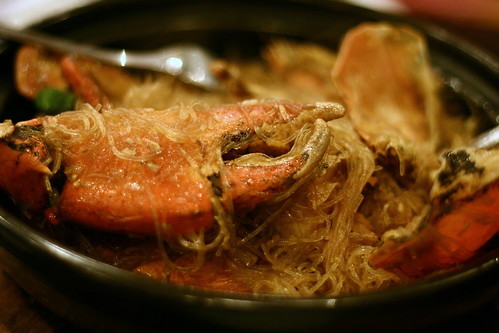Asian noodle indulgence, part 2
To continue my feature on food coma-inducing noodle dishes, here are four more umami-laden selections.
bam-i guisado, Cebu, the Philippines
I grew up in Cebu and bam-i is a popular noodle dish in my hometown. This is served everywhere and anywhere- in parties, fiestas, reunions, and whatever it is that people do when they come together. Definitely a mainstay in the local cuisine and a favorite of many a people including my wife, bam-i is probably a contortion of Hokkien ba (pork) and mee (noodles). Indonesians also call their egg noodles bakmi (pronounced with an almost imperceptible “k”). To complicate the international jumble, guisado is the Spanish term for “fried” so you can tell how hybrid this dish has become. Regardless of its derivation, this staple is a mix of two noodle types: pancit canton egg noodles and sotanghon cellophane vermicelli made of mung bean (rice noodles can be a substitute but rarely used in Cebu). It is cooked in a wok and could contain any, most if not all of these ingredients: onions, garlic, preserved Chinese pork sausage, tengang daga (black ear fungus or wood ear) and other mushroom types, cabbage, carrots, baguio beans, scallions, coriander, snow peas, pork liver strips, meat balls, chicken breast and shrimp. Flavoring comes from sesame oil, garlic, soy sauce, pepper, black peppercorns and kalamansi (local lime).
Manila Foodshoppe
The Park Mall, Mandaue City
Cebu, the Philippines
105 PHP (2.2 USD)/serving enough for 6

traditional bam-i guisado of the Manila Foodshoppe, The Park Mall, Mandaue City, Cebu, the Philippines
Canon EOS 350D Digital, 1/250s, f/1.8, 50mm, ISO 200, +1/3EV
La Paz super special misua batchoy, Iloilo City, the Philippines
Batchoy is synonymous to Iloilo, a province in the central Philippine island of Panay. Often appended with the name of the town of La Paz where it was “invented”, batchoy is most probably derived from the Hokkien ba-chui which means "pieces of meat.” The noodle variety most often used is miki, an egg noodle, but there are versions in sotanghon (made from mung bean), bihon (rice) and misua (wheat) which is the one pictured below. You can choose between pork or beef but the meat items are usually innards like heart, kidneys, liver and spleen. Rounding up the ingredients are leeks, shrimps, white chicken meat or beef and crushed chicharon or pork cracklings. The soup is a combination of shrimp broth and chicken stock, with soy sauce to taste. A raw egg can be cracked and balanced on top of the soup as a final flourish, if so desired.
I was in Iloilo last summer and finally, I was able to try out Ted’s, the acknowledged premier batchoyan or place of the La Paz batchoy. I deliberately ordered the super special misua batchoy out of curiosity as this is not at all common in the batchoy versions in Cebu. (Misua is very thin salted wheat noodles.) Batchoy servings in Ted’s come with puto manapla, a small white rice cake which I rather enjoyed. I even ordered extra puto helpings, as I needed something neutral to balance the viscously rich and heartily salty soup. Because of its high fat content, I suggest to always eat the batchoy piping hot.
Ted’s Old Timer La Paz Batchoy, SM Iloilo
Iloilo City, Iloilo, the Philippines
about 50-70 PHP (1.4USD)/serving
La Paz super special misua batchoy, Ted’s, SM Iloilo, Iloilo City, the Philippines
Canon EOS 350D Digital, 1/80s, f/1.8, 50mm, ISO 400, +1/3EV
soto ayam Ambengan Pk Sadi, Surabaya, Indonesia
As comfort food goes, the soto ayam (chicken and noodle soup) fits the bill in Indonesia. The soup is made primarily of chicken breast meat, glass noodles, slices of hard-boiled eggs, bean sprouts, cabbages and leek. It is so popular that ambulant carts roam the streets of Indonesia, from Medan through Jakarta and Bali to Bima. It took me awhile to appreciate the soup but it grows on you. (Again, the sambal chili was the clincher for me.) The chicken may come as white meat or boiled skin and adding egg is an option. The soup is yellowed with turmeric and is topped with peanut koya for additional richness. Sweating is a surefire guarantee, thanks to the spice of lombok chili, turmeric, galangal and ginger.
In Surabaya, soto ayam Ambengan of Pk Sadi, is legendary. Largely touted as having the best soto in East Java, the restaurant started as a hole-in-the-wall in the street of Ambengan by Pak Sadi (hence the name). A Chinese-Indonesian friend took me there last February of 2007, past 9PM. The eatery is still in its original spot, small, obscure and unassuming. You could not tell that there already are franchises all over the country. Parking was difficult and the late supper crowd was still bustling. Diners who just finished their meals were leaving with a smile. Soon, I did too.
Soto ayam Ambengan Pk Sadi “asli”
Jln Ambengan 3A, Surabaya, Indonesia
tel +6231 5323998
about 20,000 IDR (1.7USD)/serving
boiled rice noodle, the main ingredient of the soto ayam Ambengan Pk Sadi “asli”, Surabaya, Indonesia
Canon EOS 350D Digital, 1/25s, f/5.0, 42mm, ISO 1600
pancit Malabon
Here is one Tagalog dish that Cebuanos are not so familiar until recently. The first time I tasted this was in 2005, soon after the pancit malabon franchise hit Cebu. Cebuanos are easily familiar with the pancit palabok, which uses thinner noodles and is common all throughout the Visayas. It's a different story with pancit malabon. The larger rice noodles are not available in Cebu, which is a pity.
The platter below is about 18-20" wide and is good for more than 20 persons and only cost around 750 pesos or $15. The toppings include scallions, boiled pork, cabbage, dried shrimps, soy bean curd cubes (tofu), minced fresh garlic, parsley, asian celery, crushed chicharon fried pork crackling, squid and hard-boiled eggs with kalamansi slices for extra citric flavor. Before you say that the toppings are an overkill, the meat and veggies are so thinly-sliced (using a razor blade!). The noodles are also deep but yes, I almost hate to dig into and ruin the arrangement. The next problem is to eat in moderation. One can only try!
Canon PowerShot S40, 3/5s, f/4.5, 12.3mm









